

This part of the schema describes radiative processes including spontaneous radiative decays. Also photoabsorption (AbsorptionCrossSection and CollisionInducedAbsorptionCrossSection) is represented here. The other way to describe Collisions between photons and various objects (e.g., molecules) is in the Processes.Collisions part.
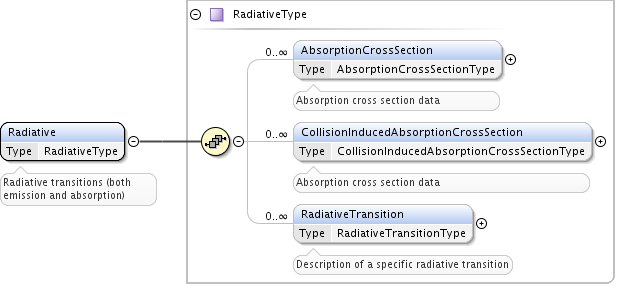
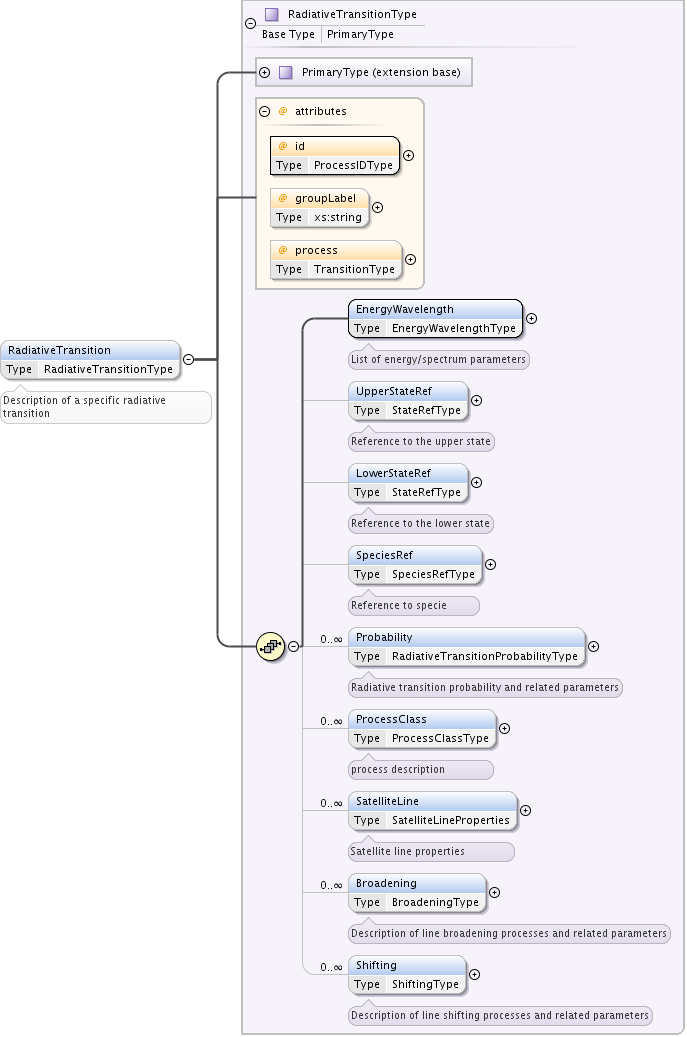
Extension of the PrimaryType. A transition is characterized by its energy/wavelength (element EnergyWavelength) and following optional attributes and elements:
- mandatory id attribute of type ProcessIDType;
- optional groupLabel attribute of type String, used to indicate arbitrary process groups;
- optional process attribute to reflect if the process is excitation or deexcitation. This attribute should always be provided and must be provided if other data in the document are associated with a specific direction of transition;
- UpperStateRef of type StateRefType, reference to the upper state of the transition;
- LowerStateRef, reference to the lower state of the transition, type StateRefType),
- SpeciesRef element of type SpeciesRefType, that may be used in place of the previous two in case of unknown states. All three references may be specified, in that case states should belong to the molecule/atom, indicated by SpeciesRef.
- list of Probability elements of type RadiativeTransitionProbabilityType. Different values of probabilities may be due to different multipole orders (e.g., M1 and E2 may be possible for the same initial and final states).
- ProcessClass element, having similar meaning as in CollisionalTransition and intended to define a class to which the transition belongs. As an example one can think of marking transitions with resolved hyperfine structure.
- multiple SatelliteLine elements,
- multiple Broadening elements,
- list of Shifting elements.
WARNING! A note should be taken that the schema has no mean so far to enforce the energy of the upper state to be higher than the energy of the lower state. Data producers should take care of it explicitly and data consumers should rely on that with the notion of the possible error condition.
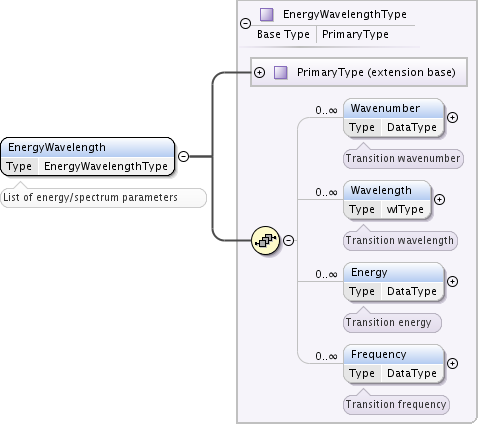
Extension of the PrimaryType, may contain multiple Wavenumber, Wavelength, Energy or Frequency elements. Exact nature of parameter must be determined through Method, with help of PrimaryType‘s method reference. Method’s Category element takes in this case values in (experiment, theory, ritz).
Wavenumber, Energy and Frequency elements are each of DataType.
Wavelength element is desribed by wlType. Extending DataType, it adds following optional elements and attributes:
- boolean vacuum attribute, defaulting to true, indicating if the value is for vacuum wavelength.
- envRef attribute, providing the reference to Environment describing the atmosphere at which the wavelength was determined.
- AirToVacuum element of DataType, providing the best available conversion multiplier to turn reported value from air into vacuum wavelength. This element should be provided if the vacuum attribute has value false.
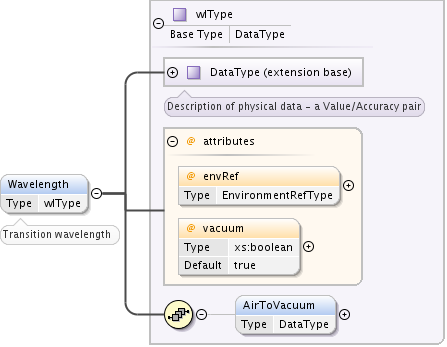
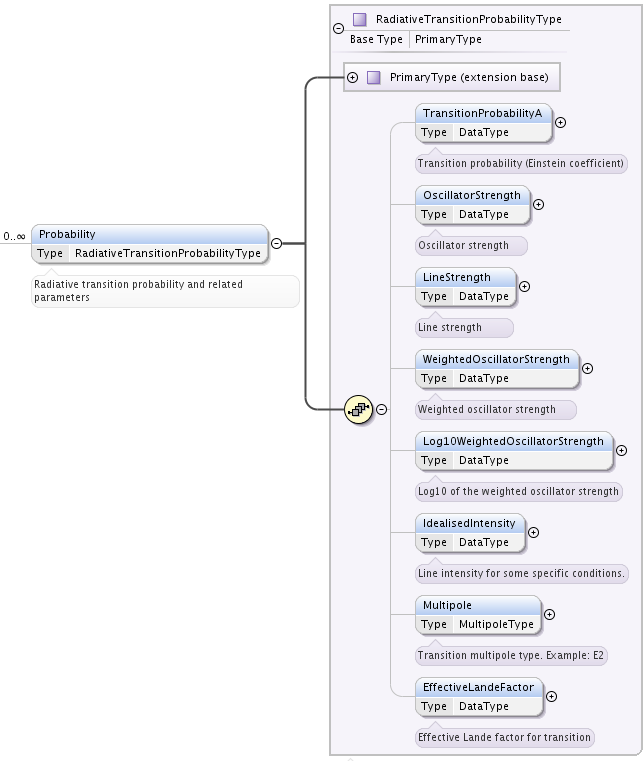
Probability element is defined as the extension of the PrimaryType. Describes parameters, relevant to transition probability. Following optional elements are possible, all of DataType if not stated otherwise:
- TransitionProbabilityA - Einstein coefficient, or transition probability.
- OscillatorStrength - Oscillator strength (dimensionless). Whether it is absorption or emission, is determined from the initial and final states of the transition.
- LineStrength - A symmetric quantity with respect to initial and final states of the transition.
- WeightedOscillatorStrength - Product of the oscillator strength and statistical weight of the initial state.
- Log10WeightedOscillatorStrength - Log_{10} of the WeightedOscillatorStrength.
- IdealisedIntensity - Line intensity under specific conditions. Due to its dependence on plasma parameters, this is not a universal property of a spectral line and thus should be used with care.
- Multipole of type MultipoleType - multipole order of a radiative transition (electric or magnetic). It is a string with the first upper-case symbol E or M followed by one or more digits, and the first digit cannot be 0.
- EffectiveLandeFactor - Effective Lande factor, line intensity coefficient for magneto-sensitive atomic lines.
if any of the probability data of a transition apply to a specific direction of transition (e.g. the weights in the WeightedOscillatorStrength can differ between absorption and emission depending on the degeneracies of the upper and lower states), then the direction of the transition must be indicated by setting the process attribute in the RadiativeTransition element. In this case, it may sometimes be necessary to write two RadiativeTransition elements, one for absorption and one for emission.
SatelliteLine element is used to keep properties of atomic optical electron satellite lines:
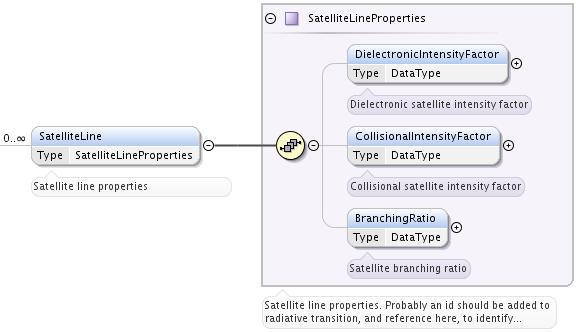
Multiple SatelliteLine elements may be specified, with three optional child elements:
- DielectronicIntensityFactor
- CollisionalIntensityFactor
- BranchingRatio
each of DataType.
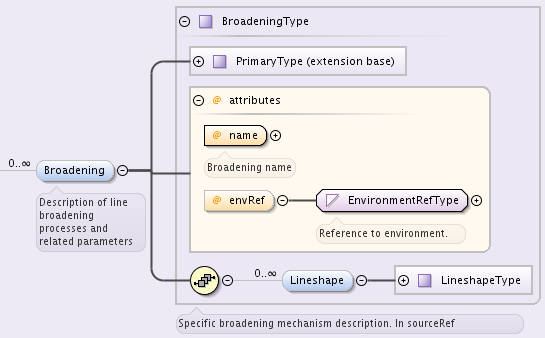
Each broadening element has
- name attribute, that must contain one of the names from Lineshapes dictionary
- envRef attribute, referencing the specific Environment conditions, for example, for collisional broadening.
- one or more Lineshape elements, with their respective parameters.
Normally, one broadening record should be created for each broadening mechanism and for each source (data origin). Many Lineshape elements allow to represent, for example, processing of the same experimental data with different lineshapes. Usually, there will be only one Lineshape element.
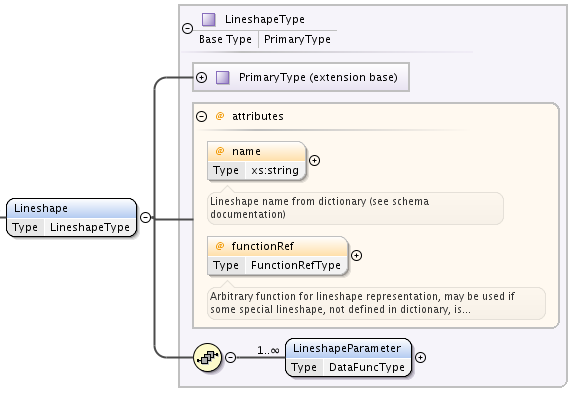
Lineshape in turn also has
- optional name attribute from Lineshapes dictionary, like Lorentz, Voigt, Doppler, etc.
- optional functionRef attribute of type FunctionRefType, with a reference to a Functions describing the lineshape. This attribute should be used only in case when the lineshape used in data fitting is absent in the Lineshapes dictionary
- one or more LineshapeParameter, each representing specific lineshape parameter as either a constant value or a function of environment parameters
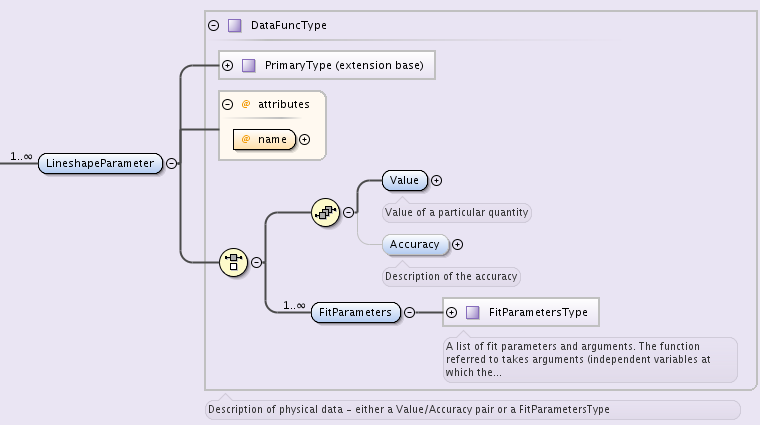
- LineshapeParameter
- either FitParameters or Value/Accuracy pair must be specified
name attribute corresponds to one defined in Lineshapes dictionary for specific lineshape
Value/Accuracy elements are the same as in DataType,
FitParameters, of type FitParametersType, that allows representation of this parameter as a function of environment parameters, for example:
<Broadening envRef="Eair-broadening-ref-env" name="pressure"> <Lineshape name="Lorentzian"> <Comments>The temperature-dependent pressure broadening Lorentzian lineshape</Comments> <LineshapeParameter name="gammaL"> <FitParameters functionRef="FgammaL"> <FitArgument units="K" name="T"> <LowerLimit>240</LowerLimit> <UpperLimit>350</UpperLimit> </FitArgument> <FitArgument units="atm" name="p"> <LowerLimit>0.</LowerLimit> <UpperLimit>1.2</UpperLimit> </FitArgument> <FitParameter name="gammaL_ref"> <SourceRef>BHIT-B_HITRAN2008</SourceRef> <Value units="1/cm">0.0635</Value> <Accuracy>0.003175</Accuracy> </FitParameter> <FitParameter name="n"> <SourceRef>BHIT-B_HITRAN2008</SourceRef> <Value units="unitless">0.75</Value> <Accuracy>0.15</Accuracy> </FitParameter> </FitParameters> </LineshapeParameter> </Lineshape> </Broadening>Where function FgammaL is defined as follows:
<Function functionID="FgammaL"> <Comments>This function gives the pressure- and temperature-dependence of the Lorentzian component of the pressure-broadened line width (HWHM)</Comments> <Expression computerLanguage="Fortran"> gammaL_ref * p * (296./T)**n </Expression> <Y name="gammaL" units="1/cm"/> <Arguments> <Argument name="T" units="K"> <Description>The absolute temperature, in K</Description> </Argument> <Argument name="p" units="atm"> <Description>The partial pressure of the broadening species, in atm</Description> </Argument> </Arguments> <Parameters> <Parameter name="gammaL_ref" units="1/cm"> <Description>The Lorentzian HWHM of the line, broadened at Tref = 296 K and broadening species partial pressure pref = 1atm</Description> </Parameter> <Parameter name="n" units="unitless"> <Description> The temperature exponent of the gammaL function </Description> </Parameter> </Parameters> </Function>
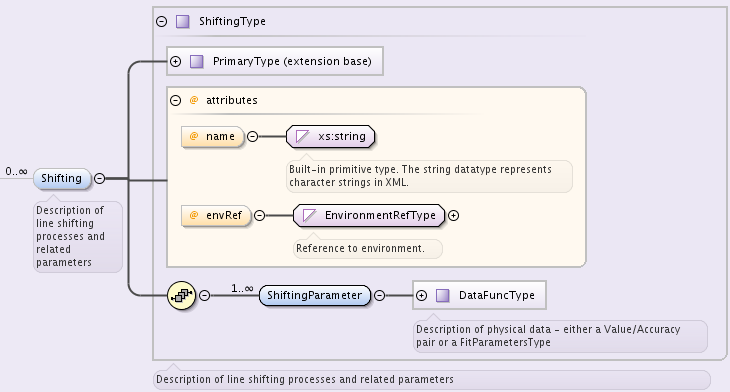
Line shifting is defined by name and/or envRef attributes. In case of linear collisional shifting, only environment is sufficient.
ShiftingParameter element is defined the same way as broadening LineshapeParameter, it is either value or function of environment parameters.
Example of a Shifting definition:
<Shifting envRef="Eair-broadening-ref-env"> <ShiftingParameter name="delta"> <FitParameters functionRef="Fdelta"> <FitArgument name="p" units="atm"> <LowerLimit>0.</LowerLimit> <UpperLimit>1.2</UpperLimit> </FitArgument> <FitParameter name="delta_ref"> <SourceRef>BHIT-B_HITRAN2008</SourceRef> <Value units="unitless">-0.001</Value> <Accuracy>0.1</Accuracy> </FitParameter> </FitParameters> </ShiftingParameter> </Shifting>
Among with RadiativeTransition elements, Processes.Radiative processes block has an AbsorptionCrossSection element which allows the description of absorption cross-section data and vibrational bands assignment in case of complex molecules.
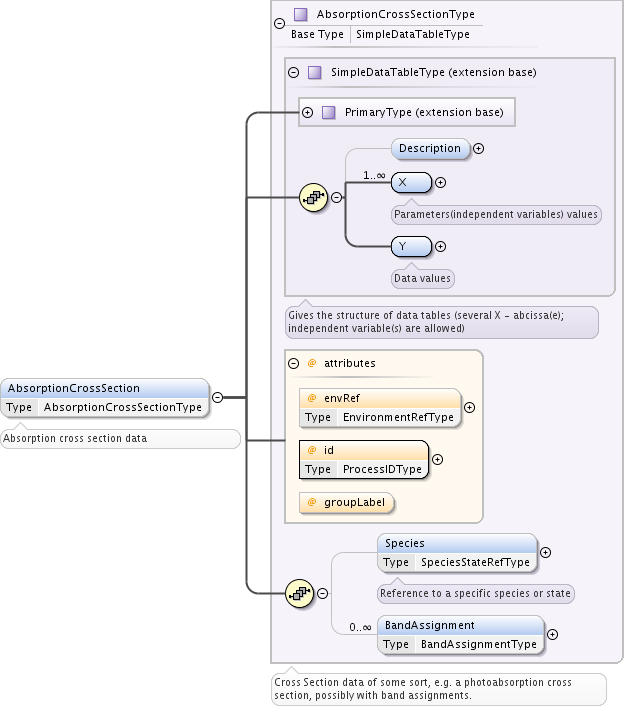
- Description, X and Y elements, derived from the SimpleDataTableType describe cross-section data in tabular form, where X can be absorbed radiation frequency, wavelength or wavenumber in a form of a list of values ( DataList ) or a sequence ( LinearSequence ). Y then represents a sequence of sigma values.
- optional envRef attribute allows to point to the Environment relevant to the data. One example would be to use it to describe absorption of some gases mixture.
- mandatory id attribute of type ProcessIDType should contain a unique process reference id,
- optional groupLabel attribute may contain an arbitrary group label string,
- optional Species element may have StateRef and/or SpeciesRef child elements, indicating species or specific states, to which crossection data applies.
- optional BandAssignment elements allow to indicate specific vibrational modes in cross-section data.
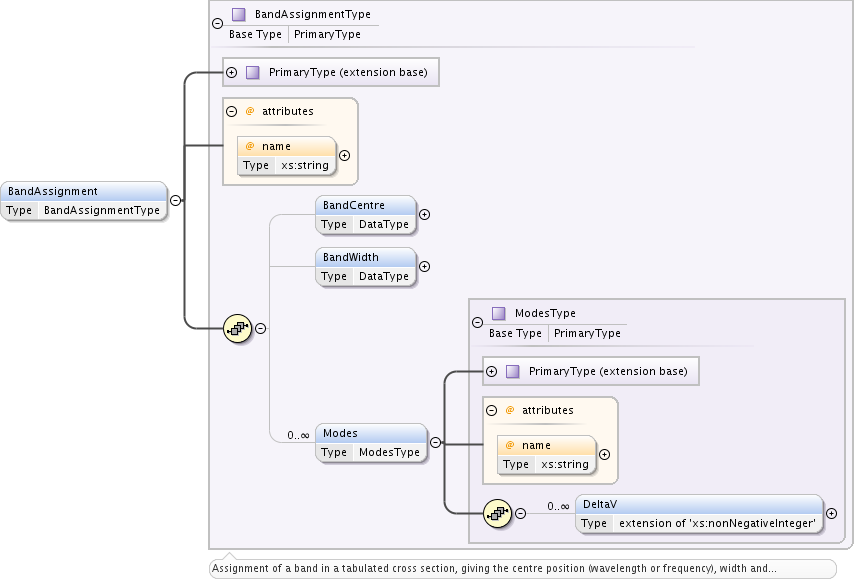
Warning: DataList is truncated for clarity, originally it contains 880 space-separated numbers. You may see the original element in schema examples (tests/valid/azulene-working.xml).
<CrossSection id="PCtest01"> <SourceRef>B_NIST1</SourceRef> <Description>The IR transmittance cross section of azulene from the NIST Standard Reference Data Program Collection</Description> <X parameter="wavenumber" units="1/cm"> <LinearSequence count="880" initial="450." increment="4"/> </X> <Y parameter="sigma" units="arbitrary"> <DataList count="880"> 0 85 94 .. 102 </DataList> </Y> <Species> <SpeciesRef>X-CUFNKYGDVFVPHO-UHFFFAOYAT</SpeciesRef> <StateRef>SX_Azulene-1</StateRef> </Species> <BandAssignment name="2v1+v2"> <BandCentre> <Value units="1/cm">410</Value> <Accuracy>2</Accuracy> </BandCentre> <BandWidth> <Value units="1/cm">40</Value> <Accuracy>5</Accuracy> </BandWidth> <Modes> <DeltaV modeID="V1">2</DeltaV> <DeltaV modeID="V2">1</DeltaV> </Modes> </BandAssignment> <BandAssignment name="3v4+2v5"> <BandCentre> <Value units="1/cm">1657</Value> <Accuracy>10</Accuracy> </BandCentre> <BandWidth> <Value units="1/cm">120</Value> <Accuracy>15.5</Accuracy> </BandWidth> <Modes> <DeltaV modeID="V2">3</DeltaV> <DeltaV modeID="V3">2</DeltaV> </Modes> </BandAssignment> </CrossSection>
This element allows to describe absorption cross-sections for short-living complexes created by collisions (e.g. N2-N2 or He-H2). Similar to the AbsorptionCrossSection description, it extends the SimpleDataTableType in the following way:
- Description, X and Y elements, derived from the SimpleDataTableType describe cross-section data in tabular form, where X can be absorbed radiation frequency, wavelength or wavenumber in a form of a list of values or a sequence. Y then represents a sequence of sigma values.
- two mandatory SpeciesRef elements of SpeciesRefType containing a reference to the species creating a molecular complex.
- optional envRef attribute allows to point to the Environment relevant to the data. It can give, for example, the environment temperature.
- mandatory id attribute of type ProcessIDType should contain a unique process reference id,
- optional groupLabel attribute may contain an arbitrary group label string,
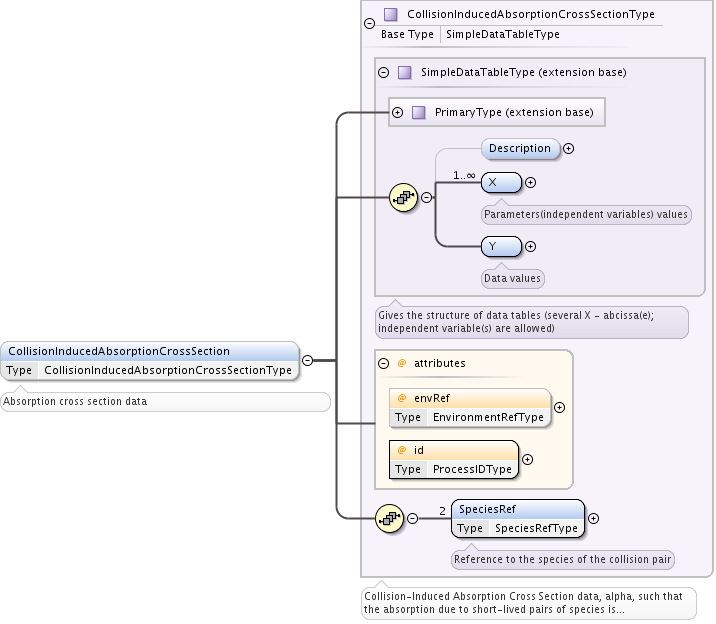
<CollisionInducedAbsorptionCrossSection envRef="EHIT-512" id="PHIT-CIA-0"> <Description>The collision-induced absorption cross section for He-H at 1500.0 K</Description> <X parameter="nu" units="1/cm"> <LinearSequence count="10951" initial="50.000000" increment="1.000000"/> </X> <Y parameter="alpha" units="cm5"> <DataFile>He-H_1500.0K_50-11000.alpha</DataFile> </Y> <SpeciesRef>XHIT-SWQJXJOGLNCZEY-UHFFFAOYSA-N</SpeciesRef> <SpeciesRef>XHIT-YZCKVEUIGOORGS-UHFFFAOYSA-N</SpeciesRef> </CollisionInducedAbsorptionCrossSection>